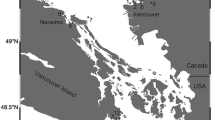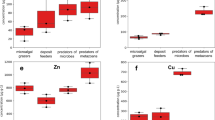Abstract
Experiments were conducted to examine the dynamics of a sediment-associated pesticide azinphosmethyl (APM) using a sublethal benthic based trophic transfer model (meiobenthic copepods to juvenile fish). Two predominant pathways for contaminant transfer during feeding, prey ingestion and sediment ingestion, were examined to determine their relative contributions to APM transfer and subsequent effects on fish brain AChE inhibition. Experiments were conducted in 1993 and in 1994. Field collected benthic copepods were exposed to 14-C labeled APM, a potent acetylcholinesterase (AChE) inhibitor, in sediments for 96 h. APM burdens were measured in the copepods, and these contaminated copepods were fed to the juvenile fish predator Leiostomus xanthurus in uncomtaminated sediments. After gut clearance, fish were examined for brain AChE activity and APM residues in the liver, heart, gut, muscle, gill, and remains. Similar experiments were conducted in which meals of uncontaminated copepods were fed to spot in APM contaminated sediments, to determine the relative contribution of contaminated sediments to APM transfer. Copepods exposed to APM at a mean sediment concentration of 1223 ng/g dry weight accumulated APM at the level of 2.5 μg/g dry tissue. Brain AChE activity was significantly depressed (23%) in the 1993 fish fed one meal of contaminated copepods, however there was no significant decline in AChE activity in the fish tested during 1994. APM accumulation in fish feeding in contaminated sediments was generally greater than in fish feeding on contaminated prey. Significant accumulation was found in bodily remains, gills, gut, and muscle in fish that fed in contaminated sediments. No significant APM accumulation was found in fish fed the contaminated copepods.
Similar content being viewed by others
References
Anderson CA, Cavagnol JC, Cohen CJ, Cohick AD, Evans RT, Everett LJ, Hensel J, Honeycutt RP, Levy ER, Loeffler WW, Nelson DL, Parr T, Waggoner TB, Young JW (1974) Guthion (azinphosmethyl): Organophosphorus insecticide. In: Gunther FA (ed) Residue Reviews, Vol 51. Springer-Verlag, NY, pp 123–180
Archambault JA, Feller RJ (1991) Diel variation in gut fullness of juvenile Spot, Leiostomus xanthurus (Pisces). Estuaries 14:94–101
Benke GM, Murphy SD (1974) Anticholinesterase action of methyl parathion and azinphosmethyl in mice and fish: onset and recovery in inhibition. Bull Environ Contam Toxicol 12:117–122
Beriman VJJ (1990) Equilibrium partitioning and biomagnification of organic chemicals in benthic animals. Environ Sci Technol 24:1407–1412
Billheimer LE, Coull BC (1988) Bioturbation and recolonization of meiobenthos in juvenile spot (Pisces) feeding pits. Est Coast Shelf Sci 27:335–340
Chandler GT (1986) High density culture of meiobenthic harpacticoid copepods within a muddy sediment substrate. Can J Fish Aquat Sci 43:53–59
Chandler GT, Scott GI (1991) Effects of sediment-bound endosulfan on survival, reproduction and larval settlement of meiobenthic polychaetes and copepods. Environ Toxicol Chem 10:375–382
Chandler GT, Scott GI, Fulton MH (1994) The acute toxicity and bioaccumulation of azinphosmethyl in benthic copepods and the development of a model for the trophic transfer of non-persistent pesticides to recreationally important finfish species. NOAA Coastal Ocean Program Project No. AN16RG0521–01R/COP3. National Marine Fisheries Service Southeast Fisheries Science Center, Charleston, SC
Coppage DL (1972) Organophosphate pesticides: Specific level of brain AChE inhibition related to death in sheepshead minnows. Trans Am Fish Soc 101:534–536
Coppage DL, Matthew E (1974) Short-term effects of organophosphate pesticides on cholinesterases of estuarine fishes and pink shrimp. Bull Environ Contam Toxicol 3:483–488
Coppage DL, Matthew E, Cook GH, Knight J (1975) Brain acetylcholinesterase inhibition in fish as a diagnosis of environmental poisoning by malathion, O,O-dimethyl S-(1,2-dicarbethoxyethyl) phosphorodithioate. Pest Biochem Physiol 5:536–542
Coull BC (1990) Are members of the meiofauna food for higher trophic levels? Trans Am Microsc Soc 109:233–246
Coull BC, Chandler GT (1992) Pollution and meiofauna: Field, laboratory, and mesocosm studies. Oceanogr Mar Biol Ann Rev 30:191–271
Cripe G, Goodman L, Hansen D (1984) Effect of chronic exposure to EPN and to Guthion on the critical swimming speed and brain acetylcholinesterase activity of Cyprinodon variegatus. Aquatic Tox 5:255–266
de Bruijn J, Hermens J (1991) Uptake and elimination kinetics of organophosphorous pesticides in the guppy (Poecilia reticulata): correlations with the octanol/water partition coefficient. Environ Toxicol Chem 10:791–804
Derache R (1977) Organophosphorous pesticides. Pergamon Press Inc, NY 199 pp
DiPinto LM, Coull BC, Chandler GT (1993) Lethal and sublethal effects of the sediment-associated PCB Aroclor 1254® on a meiobenthic copepod. Environ Toxicol Chem 12:1909–1918
DiToro DM, Zarba CS, Hansen DJ, Berry WJ, Swartz RC, Cowan CE, Pavlou SP, Allen HE, Thomas NA, Paquin PR (1991) Technical basis for establishing sediment quality criteria for nonionic organic chemicals using equilibrium partitioning. Environ Toxicol Chem 10:1541–1587
Ellis MJ, Coull BC (1989) Predation on meiobenthios: field experiments using juvenile spot (Pisces). J Exp Mar Biol Ecol 130:19–32
Ellman G, Courtney K, Andres VJ, Featherstone R (1961) A new and colorimetric determination of acetylcholinesterase activity. Biochem Pharmacol 7:88–95
Eto M (1974) OP Pesticides: Organic and Biological Chemistry. CRC Press, Cleveland, 387 pp
Feller RJ, Coull BC (1995) Non-selective ingestion of meiobenthos by juvenile spot (Leiostomus xanthurus) (Pisces) and their daily ration. Vie Milieu 45:49–60
Ferrando MD, Gamon M, Andreu E (1992) Accumulation and distribution of pesticides in Anguilla anguilla from Albufera Lake (Spain). J Environ Biol 13:75–82
Findlay SEG (1981) Small scale spatial distribution of meiofauna on a mud- and sandflat. Est Coast Shelf Sci 12:471–484
Fisher Scientific (1993) Product Technical Information for Scintigest (SX10). Fisher Chemicals, Fair Lawn, NJ
Fulton MH (1989) The effects of certain intrinsic and extrinsic variables on the lethal and sublethal toxicity of selected organophosphorus insecticides in the mummichog, Fundulus heteroclitus under laboratory and field conditions. PhD Dissertation, Univ. South Carolina, Columbia, SC
Gee JM (1989) An ecological and economic review of meiofauna as food for fish. Zool J Linnean Soc 96:243–261
Kennedy VS (ed) (1984) The Estuary as a Filter. Proceedings of the 7th Biennial International Estuarine Research Conference. Academic Press, NY, 511 pp
Lowry O, Rosebrough N, Farr A, Randall R (1951) Protein measurements with the folin phenol reagent. J Biol Chem 193:265–275
Main AR (1979) Mode of action of anticholinesterases. Pharmac Ther 6:579–628
Martinez-Tabche L, Galar CI, Ramirez MB, Morales RA (1994) Parathion effect on acetylcholinesterase from fish through an artificial trophic chain: Ankistrodesmum falcatus-Moina macrocopa-Oreochromis hornorum. Bull Environ Contam Toxicol 52:360–366
McCall JN, Fleeger JW (1993) Recognition and utilization of prey aggreagations by juvenile spot (Leiostomus xanthurus). J Exp Mar Biol Ecol 174:121–134
McCall JN, Fleeger JW (1993) Recognition and utilization of prey aggregations by juvenile spot (Leiostomus xanthurus). J Exp Mar Biol Ecol 174:121–134
Meyer FP (1965) The experimental use of Guthion as a selective fish eradicator. Trans Am Fish Soc 94:203–209
Meyers SP, Gambrell RP, Day JWJ (1982) Determination of the environmental impact of several substitute chemicals in agriculturally affected wetlands. Gulf Breeze FL, Environmental Research Laboratory, US EPA 600/4-82-052
Nelson AL, Coull BC (1989) Selection of meiobenthic prey by juvenile spot (Pisces): an experimental study. Mar Ecol Prog Ser 53:51–57
Pimental D, Edwatds CA (1982) Pesticides and Ecosystems. Bioscience 32:595–600
SAS Institute (1988) SAS/STAT User's Guide. Release 6.03 Edition. Cary, NC
Scholz DS, Matthews LL, Feller RJ (1991) Detecting selective digestion of meiobenthic prey by juvenile spot Leiostomus xanthurus (Pisces) using immunoassays. Mar Ecol Prog Ser 72:59–67
Scott GI, Fulton MH, Moore DW, Chandler GT, Key PB, Hampton TW, Marcus JM, Jackson KL, Baughman DS, Trim AH, Williams L, Louden CJ, Patterson ER (1987) Agricultural insecticide runoff effects on estuarine organisms: correlating laboratory and field toxicity testing with ecotoxicological biomonitoring. Technical Report. US Environmental Protection Agency, Gulf Breeze, FL
Sigma Chemical Co. (1985) Sigma Technical Bulletin, Protein Assay Kit No. P5656. Sigma Chemical Company, St. Louis, MO
Sokal RF, Rolf FJ (1981) Biometry. W.H. Freeman, San Francisco, CA
Southerland E, Kravitz M, Wall T (1992) Sediment Toxicity Assessment. Lewis Publishers, Boca Raton, FL
Swartz RC, Lee H III (1980) Biological processes affecting the distribution of pollutants in marine sediments. Part 1. Accumulation, trophic transfer, biodegradation, and migration. In: Baker RA (ed) Contaminants and Sediments, 1st ed., Vol. 2. Ann Arbor Science Publishers, Inc., Ann Arbor, pp 533–553
United States Environmental Protection Agency (1986) Pesticide fact sheet No. 100: Azinphosmethyl. 72–79 Washington, DC
Weiss CM (1961) Physiological effect of organic phosphorus insecticides on several species of fish. Trans Am Fish Soc 90:143–152
Yetman KT (1979) The morphology of the bucco-pharyngeal filter of an estuarine fish, the spot, Leiostomus xanthurus. Master's Thesis, University of South Carolina, Columbia, SC
Author information
Authors and Affiliations
Additional information
Contribution No. 1073 of the Belle W. Baruch Institute for Marine Biology & Coastal Research
Rights and permissions
About this article
Cite this article
DiPinto, L.M. Trophic transfer of a sediment-associated organophosphate pesticide from meiobenthos to bottom feeding fish. Arch. Environ. Contam. Toxicol. 30, 459–466 (1996). https://doi.org/10.1007/BF00213396
Received:
Revised:
Issue Date:
DOI: https://doi.org/10.1007/BF00213396




